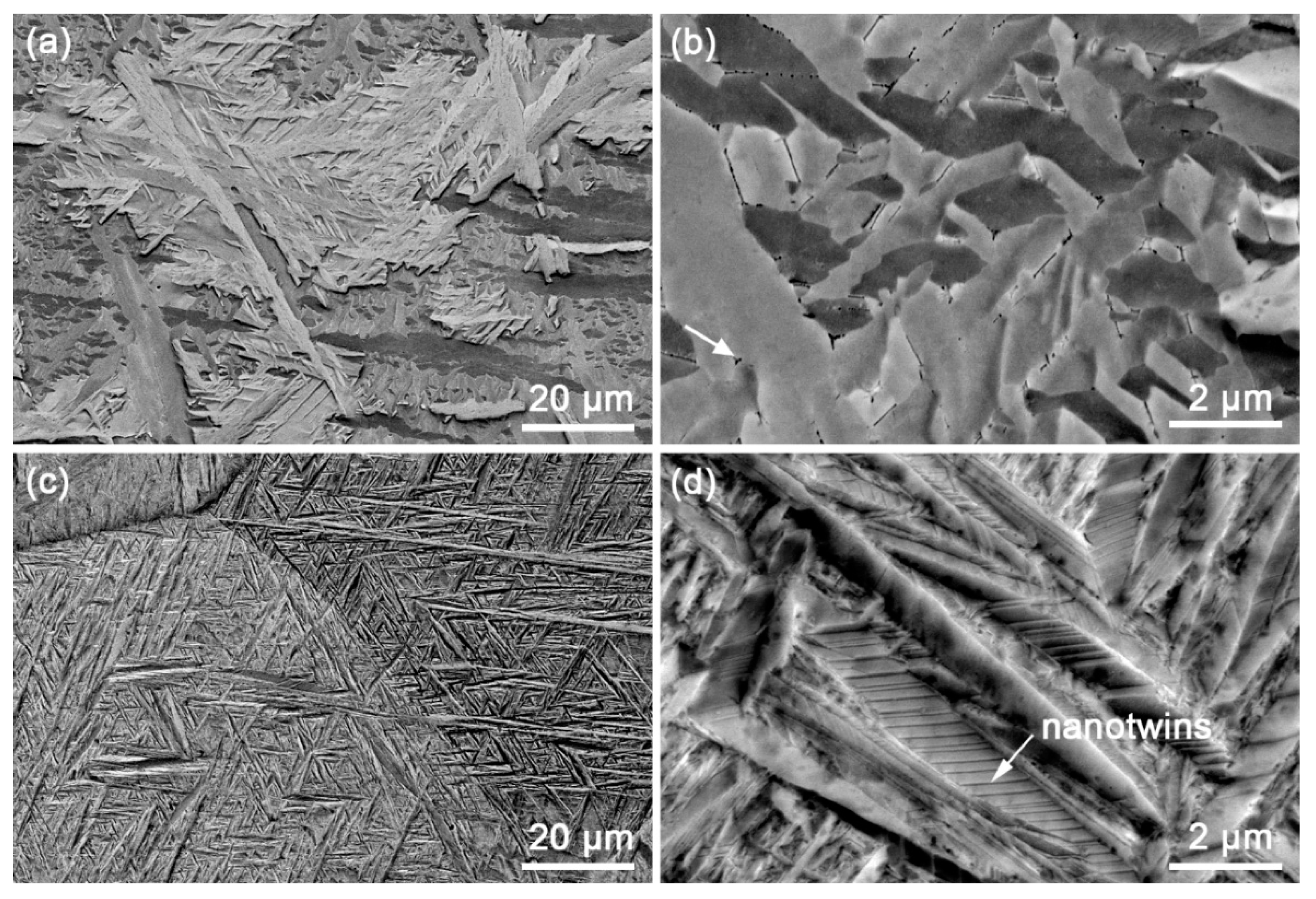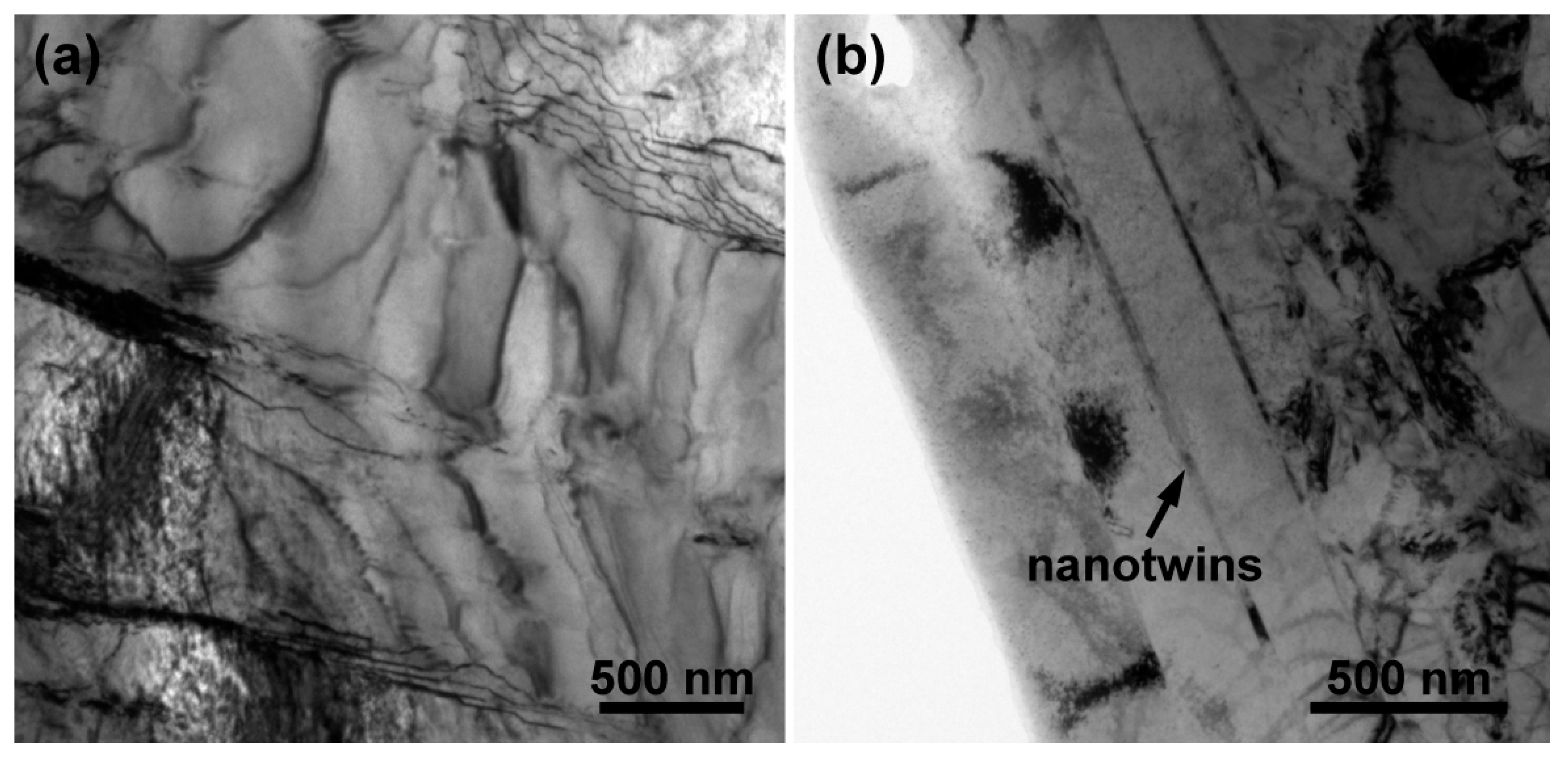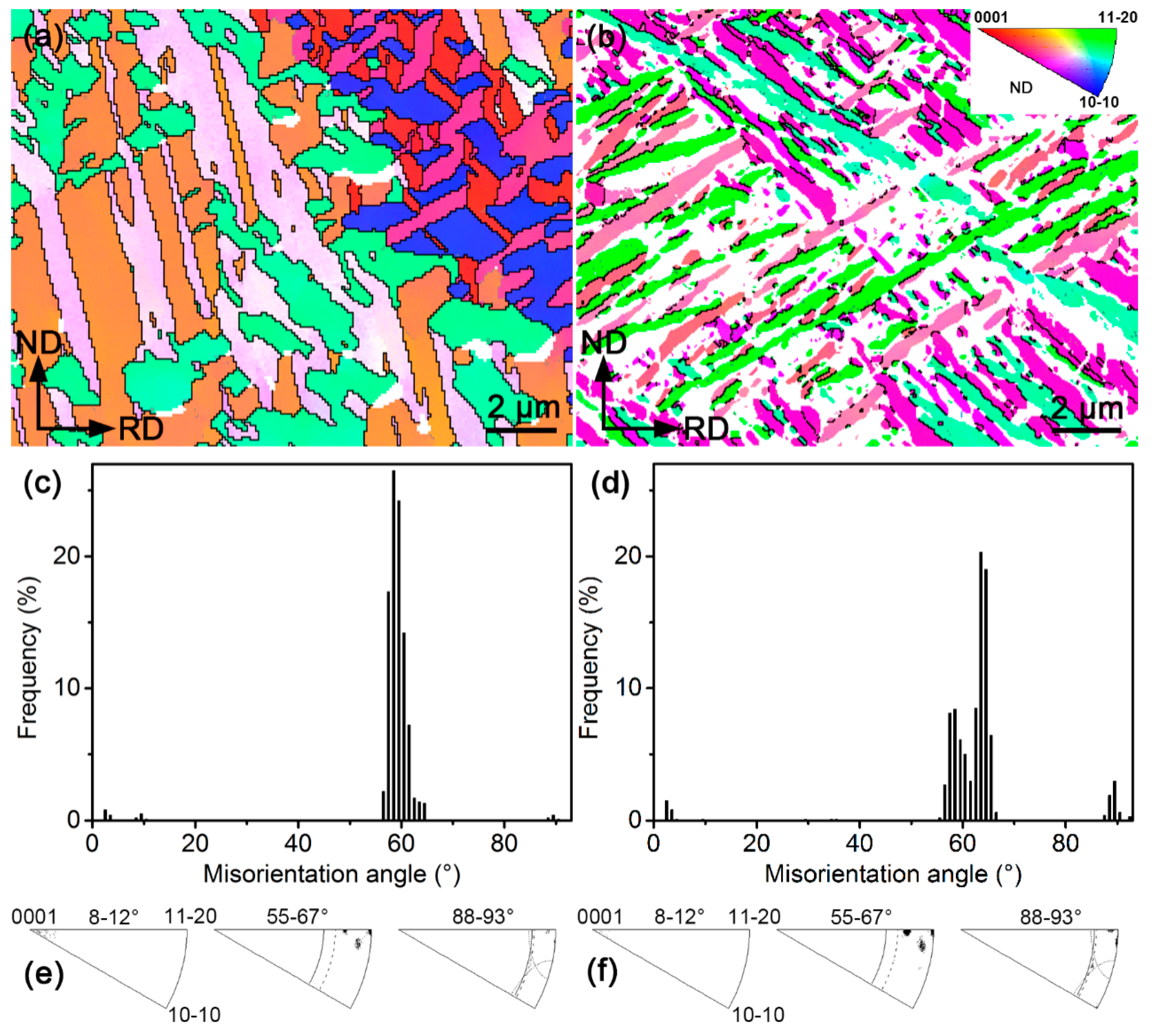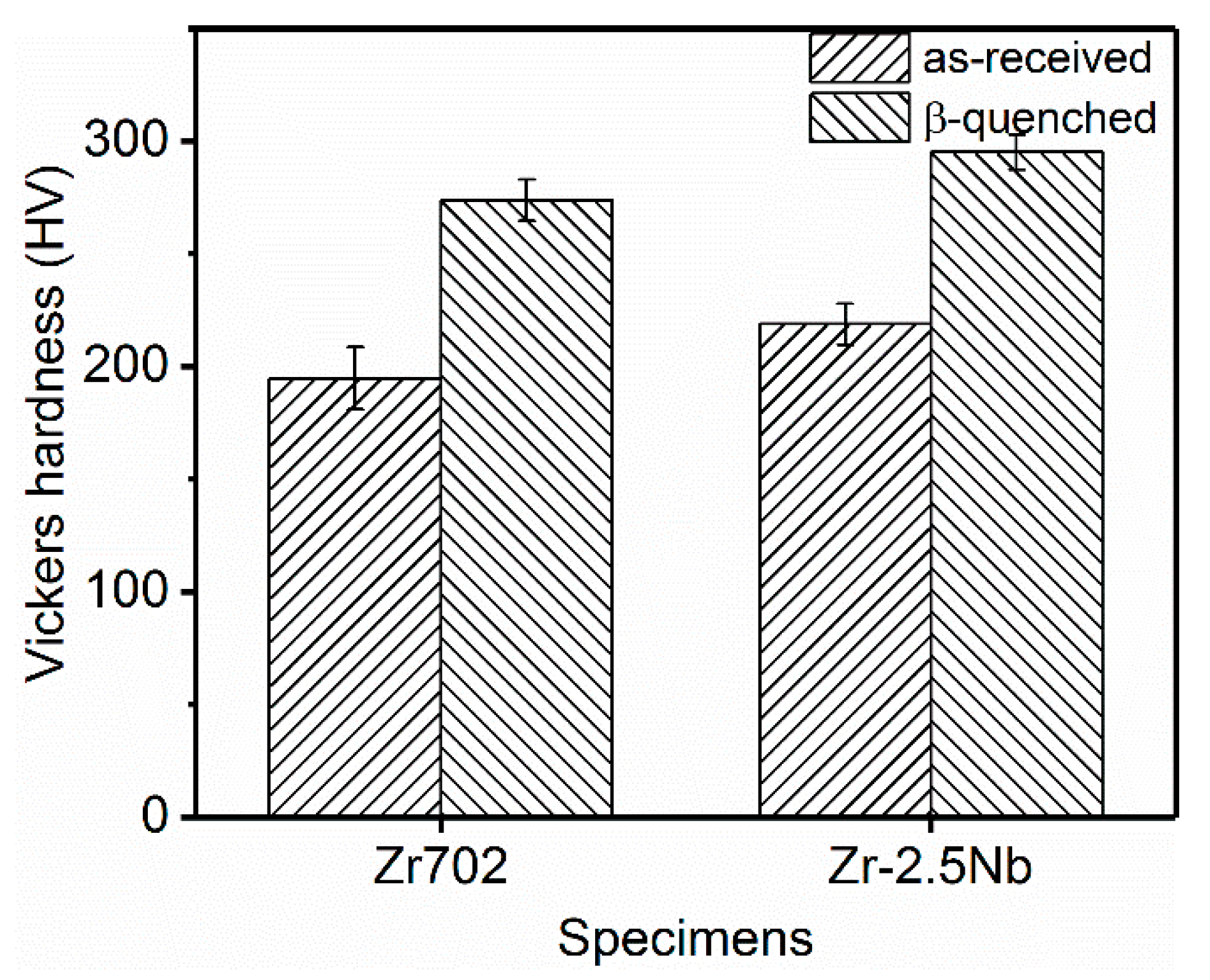Comparative Study of Microstructural Characteristics and Hardness of β-Quenched Zr702 and Zr–2.5Nb Alloys
Abstract
:1. Introduction
2. Experimental
3. Results
3.1. Microstructural Characteristics
3.2. Hardness Measurements
4. Discussion
4.1. Microstructural Differences between β-Quenched Zr702 and Zr–2.5Nb
4.2. Correlation between Hardness and Microstructural Characteristics
5. Conclusions
Author Contributions
Funding
Conflicts of Interest
References
- Tang, C.C.; Stueber, M.; Seifert, H.J.; Steinbrueck, M. Protective coatings on zirconium-based alloys as accident-tolerant fuel (ATF) claddings. Corros. Rev. 2017, 35, 141–165. [Google Scholar] [CrossRef]
- Bai, W.M.; Xu, G.M.; Tan, M.Y.; Yang, Z.J.; Zeng, L.J.; Wu, D.; Liu, L.B.; Zhang, L.G. Diffusivities and atomic mobilities in bcc Ti-Mo-Zr alloys. Materials 2018, 11, 1909. [Google Scholar] [CrossRef] [PubMed]
- Yau, T.L.; Annamalai, V.E. Corrosion of zirconium and its alloys. Refer. Mod. Mater. Sci. Mater. Eng. 2016, 3, 2094–2134. [Google Scholar]
- Mehjabeen, A.; Song, T.; Xu, W.; Tang, H.P.; Qian, M. Zirconium alloys for orthopaedic and dental applications. Adv. Eng. Mater. 2018, 20, 1800207. [Google Scholar] [CrossRef]
- Andrei, V.S.; Madalina, S.B.; Marcin, N.; Adriana, S.; Petrica, V. Characterization and mechanical proprieties of new TiMo alloys used for medical applications. Materials 2019, 12, 2973. [Google Scholar]
- Okamoto, H. Sn-Zr (Tin-Zirconium). J. Phase Equilib. Diff. 2010, 31, 411–412. [Google Scholar] [CrossRef]
- Burgers, W.G. On the process of transition of the cubic-body-centered modification into the hexagonal-close-packed modification of zirconium. Physica 1934, 1, 561–586. [Google Scholar] [CrossRef]
- Hiwarkar, V.D.; Sahoo, S.K.; Samajdar, I.; Narasimhan, K.; Krishna, K.V.M.; Dey, G.K.; Srivastava, D.; Tewari, R.; Banerjee, S. Annealing of cold worked two-phase Zr-2.5Nb-Associated microstructural developments. J. Nucl. Mater. 2009, 384, 30–37. [Google Scholar] [CrossRef]
- Daymond, M.R.; Holt, R.A.; Cai, S.; Mosbrucker, P.; Vogel, S.C. Texture inheritance and variant selection through an hcp–bcc–hcp phase transformation. Acta Mater. 2010, 58, 4053–4066. [Google Scholar] [CrossRef]
- Dahlback, M.; Limback, M.; Hallstadius, L.; Barberis, P.; Bunel, G.; Simonot, C.; Andersson, T.; Askeljung, P.; Flygare, J.; Lehtinen, B.; et al. The effect of β-quenching in final dimension on the irradiation growth of tubes and channels. J. ASTM Int. 2005, 2, 276–304. [Google Scholar] [CrossRef]
- Kim, H.G.; Park, S.Y.; Lee, M.H.; Jeong, Y.H.; Kim, S.D. Corrosion and microstructural characteristics of Zr-Nb alloys with different Nb contents. J. Nucl. Mater. 2008, 373, 429–432. [Google Scholar] [CrossRef]
- Crepin, J.; Bretheau, T.; Caldemaison, D.; Barbu, A.; Jazkierowitcz, G. Microstructural study of β treated grade 702 zirconium. Scanning electron microscopy and transmission electron microscopy, complementarity of two observational scales. J. Mater. Sci. 1991, 32, 4841–4846. [Google Scholar] [CrossRef]
- Kim, H.G.; Baek, J.H.; Kim, S.D.; Jeong, Y.H. Microstructure and corrosion characteristics of Zr-1.5Nb-0.4Sn-0.2Fe-0.1Cr alloy with a β-annealing. J. Nucl. Mater. 2008, 372, 304–311. [Google Scholar] [CrossRef]
- Massih, A.R.; Andersson, T.; Witt, P.; Dahlbäck, M.; Limbäck, M. Effect of quenching rate on the β-to-α phase transformation structure in zirconium alloy. J. Nucl. Mater. 2003, 322, 138–151. [Google Scholar] [CrossRef]
- Srivastava, D.; Mukhopadhyay, P.; Banerjee, S.; Ranganathan, S. Morphology and substructure of lath martensites in dilute Zr-Nb alloys. Mater. Sci. Eng. A 2000, 288, 101–110. [Google Scholar] [CrossRef]
- Massih, A.R.; Dahlback, V.; Limback, M.; Andersson, T.; Lehtinen, B. Effect of β-to-α phase transition rate on corrosion behaviour of zircaloy. Corros. Sci. 2006, 48, 1154–1181. [Google Scholar] [CrossRef]
- Chai, L.; Luan, B.; Chen, B.; Yang, H.; Liu, Q.; Huang, W. Concurrent inheritance of microstructure and texture after slow β→α cooling of commercially pure Zr. Sci. China Technol. Sci. 2016, 59, 1771–1776. [Google Scholar] [CrossRef]
- Chai, L.; Chen, K.; Wang, S.Y.; Xia, J.Y.; Wang, T.T.; Yang, Z.N. Microstructural characteristics of as-forged and β-air-cooled Zr–2.5Nb alloy. Trans. Nonferr. Met. Soc. China 2018, 28, 1321–1328. [Google Scholar] [CrossRef]
- Woo, O.T.; Tangri, K. Transformation characteristics of rapidly heated and quenched zircaloy-4-oxygen alloys. J. Nucl. Mater. 1979, 79, 83–94. [Google Scholar] [CrossRef]
- Ben Ammar, Y.; Aoufi, A.; Darrieulat, M. Influence of the cooling rate on the texture and the microstructure of Zircaloy-4 studied by means of a Jominy end-quench test. Mater. Sci. Eng. A 2012, 556, 184–193. [Google Scholar] [CrossRef]
- Cheng, Z.Q.; Sui, Z.B.; Yin, H.; Feng, H. Numerical simulation of dynamic fracture in functionally graded materials using peridynamic modeling with composite weighted bonds. Eng. Anal. Bound. Elem. 2019, 105, 31–46. [Google Scholar] [CrossRef]
- Cheng, Z.Q.; Wang, Z.Y.; Luo, Z.T. Dynamic crack propagation and branching in shale materials by peridynamic method. CMES Comp. Model. Eng. Sci. 2019, 118, 509–527. [Google Scholar]
- Zaefferer, S.; Elhami, N.-N. Theory and application of electron channelling contrast imaging under controlled diffraction conditions. Acta Mater. 2014, 75, 20–50. [Google Scholar] [CrossRef]
- Liu, W.B.; Jin, X.; Zhang, B.; Yun, D.; Chen, P.H. A coupled ebsd/tem analysis of the microstructure evolution of a gradient nanostructured ferritic/martensitic steel subjected to surface mechanical attrition treatment. Materials 2019, 12, 140. [Google Scholar] [CrossRef] [PubMed]
- Jiang, Y.L.; Liu, H.Q.; Yi, D.Q.; Lin, G.Y.; Dai, X.; Zhang, R.Q.; Sun, Y.D.; Liu, S.Q. Microstructure evolution and recrystallization behavior of cold-rolled Zr-1Sn-0.3Nb-0.3Fe-0.1Cr alloy during annealing. Trans. Nonferr. Met. Soc. China 2018, 28, 651–661. [Google Scholar] [CrossRef]
- Yang, H.L.; Kano, S.; Matsukawa, Y.; Li, Y.F.; Shen, J.J.; Zhao, Z.S.; Li, F.; Satoh, Y.; Abe, H. Study on recrystallization and correlated mechanical properties in Mo-modified Zr-Nb alloys. Mater. Sci. Eng. A 2016, 661, 9–18. [Google Scholar] [CrossRef]
- Liu, C.; Li, G.; Yuan, F.; Han, F.; Zhang, Y.; Gu, H. Stacking faults in Zr(Fe, Cr)2 Laves structured secondary phase particle in Zircaloy-4 alloy. Nanoscale 2018, 10, 2249–2254. [Google Scholar] [CrossRef]
- Chai, L.; Wang, S.; Wu, H.; Guo, N.; Pan, H.; Chen, L.; Murty, K.L.; Song, B. α→β Transformation characteristics revealed by pulsed laser-induced non-equilibrium microstructures in duplex-phase Zr alloy. Sci. China Technol. Sci. 2017, 60, 1255–1262. [Google Scholar] [CrossRef]
- Chai, L.; Luan, B.; Zhang, M.; Murty, K.L.; Liu, Q. Experimental observation of 12 α variants inherited from one β grain in a Zr alloy. J. Nucl. Mater. 2013, 440, 377–381. [Google Scholar] [CrossRef]
- Yao, M.Y.; Zhou, B.X.; Li, Q.; Liu, W.Q.; Geng, X.; Lu, Y.P. A superior corrosion behavior of Zircaloy-4 in lithiated water at 360 °C/18.6 MPa by β-quenching. J. Nucl. Mater. 2008, 374, 197–203. [Google Scholar] [CrossRef]
- Holt, R.A. The β to α phase transformation in zircaloy-4. J. Nucl. Mater. 1970, 35, 322–334. [Google Scholar] [CrossRef]
- Tewari, R.; Srivastava, D.; Dey, G.K.; Chakravarty, J.K.; Banerjee, S. Microstructural evolution in zirconium based alloys. J. Nucl. Mater. 2008, 383, 153–171. [Google Scholar] [CrossRef]
- Northwood, D.O.; Lim, D.T. Phase-transformations in zirconium and its alloys. Can. Metall. Q. 1979, 18, 441–467. [Google Scholar] [CrossRef]
- Hunt, C.E.L.; Niessen, P. The continuous cooling transformation behaviour of zirconium-niobium-oxygen alloys. J. Nucl. Mater. 1971, 38, 17–25. [Google Scholar] [CrossRef]
- Jeong, Y.H.; Lee, K.O.; Kim, H.G. Correlation between microstructure and corrosion behavior of Zr-Nb binary alloy. J. Nucl. Mater. 2002, 302, 9–19. [Google Scholar] [CrossRef]
- Gros, J.P.; Wadier, J.F. Precipitate growth kinetics in Zircaloy-4. J. Nucl. Mater. 1990, 172, 85–96. [Google Scholar] [CrossRef]
- Gault, B.; Felfer, P.J.; Ivermark, M.; Bergqvist, H.; Cairney, J.M.; Ringer, S.P. Atom probe microscopy characterization of as quenched Zr–0.8 wt.% Fe and Zr–0.15 wt.% Cr binary alloys. Mater. Lett. 2013, 91, 63–66. [Google Scholar] [CrossRef]
- Thuvander, M.; Andrén, H.O. Methods of quantitative matrix analysis of Zircaloy-2. Ultramicroscopy 2011, 111, 711–714. [Google Scholar] [CrossRef]
- Ahmmed, K.F.; Daymond, M.R.; Gharghouri, M.A. Microstructural evaluation and crystallographic texture modification of heat-treated zirconium Excel pressure tube material. J. Alloys Compd. 2016, 687, 1021–1033. [Google Scholar] [CrossRef]
- Chai, L.; Xia, J.; Zhi, Y.; Chen, K.; Wang, T.; Song, B.; Guo, N. Strengthening or weakening texture intensity of Zr alloy by modifying cooling rates from α + β region. Mater. Chem. Phys. 2018, 213, 414–421. [Google Scholar] [CrossRef]
- Farabi, E.; Hodgson, P.D.; Rohrer, G.S.; Beladi, H. Five-parameter intervariant boundary characterization of martensite in commercially pure titanium. Acta Mater. 2018, 154, 147–160. [Google Scholar] [CrossRef]
- Chauvy, C.; Barberis, P.; Montheillet, F. Microstructure transformation during warm working of β-treated lamellar Zircaloy-4 within the upper α-range. Mater. Sci. Eng. A 2006, 431, 59–67. [Google Scholar] [CrossRef]
- Meyers, M.A.; Vöhringer, O.; Lubarda, V.A. The onset of twinning in metals: A constitutive description. Acta Mater. 2001, 49, 4025–4039. [Google Scholar] [CrossRef]
- Yang, H.L.; Shen, J.J.; Matsukawa, Y.; Satoh, Y.; Kano, S.; Zhao, Z.S.; Li, Y.F.; Li, F.; Abe, H. Effects of alloying elements (Sn, Nb, Cr, and Mo) on the microstructure and mechanical properties of zirconium alloys. J. Nucl. Sci. Technol. 2015, 52, 1162–1173. [Google Scholar] [CrossRef]
- Cai, S.; Daymond, M.R.; Holt, R.A. Deformation of high β-phase fraction Zr–Nb alloys at room temperature. Acta Mater. 2012, 60, 3355–3369. [Google Scholar] [CrossRef]
- Zhang, M.; Zhang, F.; Yang, Z.; Li, Y.; Qu, L.; Zhen, H. Effect of cooling process on the formation of duplex microstructure in Zr–2.3Nb alloy. J. Alloys Compd. 2015, 651, 316–321. [Google Scholar] [CrossRef]
- Chai, L.; Luan, B.; Xiao, D.; Zhang, M.; Murty, K.L.; Liu, Q. Microstructural and textural evolution of commercially pure Zr sheet rolled at room and liquid nitrogen temperatures. Mater. Des. 2015, 85, 296–308. [Google Scholar] [CrossRef]
- Chai, L.; Chen, K.; Zhi, Y.; Murty, K.L.; Chen, L.-Y.; Yang, Z. Nanotwins induced by pulsed laser and their hardening effect in a Zr alloy. J. Alloys Compd. 2018, 748, 163–170. [Google Scholar] [CrossRef]






| Alloy | Hf | Nb | Fe | Cr | O | Zr |
|---|---|---|---|---|---|---|
| Zr702 | 1.15 | - | 0.07 | ~0.01 | 0.15 | Bal. |
| Zr–2.5Nb | - | 2.50 | <0.10 | - | 0.10 | Bal. |
| Alloy | Zr702 | Zr–2.5Nb | ||
|---|---|---|---|---|
| As-Received | β-Quenched | As-Received | β-Quenched | |
| Measured hardness, H (HV) | 194.8 | 273.8 | 218.8 | 295.2 |
| β-quenching induced hardness increment, ΔH (HV) | - | 79.0 | - | 76.4 |
| Grain size, d (μm) | 8.3 | 0.8 | 1.4 | 0.3 |
| Hardness contribution calculated using H-P equation, HHP (HV) | 30.1 | 100.1 | 73.3 | 155.7 |
| Hardness increment contributed from β-quenching induced grain refinement, ΔHHP (HV) | - | 70.0 | - | 82.4 |
© 2019 by the authors. Licensee MDPI, Basel, Switzerland. This article is an open access article distributed under the terms and conditions of the Creative Commons Attribution (CC BY) license (http://creativecommons.org/licenses/by/4.0/).
Share and Cite
Dai, J.; Guan, H.; Chai, L.; Xiang, K.; Zhu, Y.; Qiu, R.; Guo, N.; Liu, Y. Comparative Study of Microstructural Characteristics and Hardness of β-Quenched Zr702 and Zr–2.5Nb Alloys. Materials 2019, 12, 3752. https://doi.org/10.3390/ma12223752
Dai J, Guan H, Chai L, Xiang K, Zhu Y, Qiu R, Guo N, Liu Y. Comparative Study of Microstructural Characteristics and Hardness of β-Quenched Zr702 and Zr–2.5Nb Alloys. Materials. 2019; 12(22):3752. https://doi.org/10.3390/ma12223752
Chicago/Turabian StyleDai, Jiahong, Haotian Guan, Linjiang Chai, Kang Xiang, Yufan Zhu, Risheng Qiu, Ning Guo, and Yuanzhuo Liu. 2019. "Comparative Study of Microstructural Characteristics and Hardness of β-Quenched Zr702 and Zr–2.5Nb Alloys" Materials 12, no. 22: 3752. https://doi.org/10.3390/ma12223752
APA StyleDai, J., Guan, H., Chai, L., Xiang, K., Zhu, Y., Qiu, R., Guo, N., & Liu, Y. (2019). Comparative Study of Microstructural Characteristics and Hardness of β-Quenched Zr702 and Zr–2.5Nb Alloys. Materials, 12(22), 3752. https://doi.org/10.3390/ma12223752






